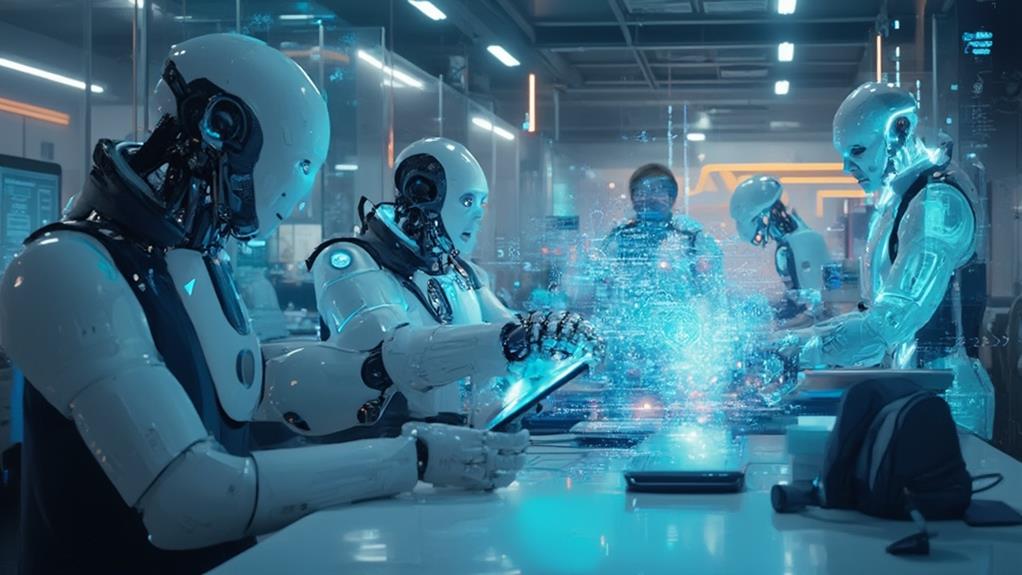Automation is revolutionizing the workplace by transforming productivity, efficiency, and workforce roles. By integrating AI and IoT, it allows businesses to replace manual operations with optimized, intelligent workflows. This shift frees employees from mundane tasks, enabling them to engage in high-value strategic activities and foster personal and professional growth. Tools like robotic process automation enhance operational efficiency by combining AI and machine learning for superior decision-making. As businesses reshape their culture, they align technology with human creativity, driving innovation. The future of work promises dynamic changes where embracing automation isn’t just an option—it’s a strategic necessity to stay competitive. Discover more about this transformative shift.
Table of Contents
Key Takeaways
- Automation enhances productivity by replacing manual operations with optimized, AI-driven workflows.
- Robotic Process Automation streamlines routine tasks, allowing employees to focus on strategic and creative activities.
- Integrating AI and IoT enables intelligent decision-making and continuous improvement in business processes.
- Automation reshapes business culture, fostering innovation and maximizing employees’ potential for strategic thinking.
- Future work dynamics will see a shift to flexible roles, emphasizing skill development and technology synergy.
Understanding Process Automation

Understanding process automation is pivotal in today’s rapidly evolving business environment. This transformative approach leverages digital technology to automate tasks traditionally requiring human involvement, aiming to enhance productivity by replacing manual operations.
By integrating AI and IoT, businesses can make intelligent decisions and drive continuous improvement. At its core, process automation is about process optimization, streamlining workflows to achieve maximum efficiency.
It enables task delegation, freeing human capital to focus on high-value, strategic activities rather than mundane, repetitive duties. By embracing automation, businesses not only reduce human error but also empower their workforce, fostering a liberated, innovative culture.
This paradigm shift is not merely about replacing tasks but reshaping the way we work. In an era where freedom and flexibility are paramount, integrating automation becomes a strategic necessity for forward-thinking enterprises.
Key Automation Tools
In the domain of automation, key tools such as AI-driven software and robotic systems stand at the forefront, transforming traditional business operations into streamlined, efficient processes.
Automation software is not merely a tool but a revolution, liberating businesses from the shackles of inefficiency. AI applications enhance decision-making and redefine customer experiences, offering businesses a competitive edge.
For instance, predictive analytics utilized by 52% of organizations optimizes operational strategies and enhances decision-making. Additionally, continuous AI operations enable 24/7 task completion, improving overall productivity and customer satisfaction.
These tools empower organizations to break free from the constraints of manual operations, embracing a future where innovation leads. Automation software and AI applications are catalysts for change, allowing enterprises to focus on creativity and strategic growth.
Robotic Process Automation

Robotic Process Automation (RPA) serves as a pivotal force in the modern business landscape, fundamentally transforming how routine tasks are executed. By harnessing robotic efficiency, RPA revolutionizes operations, allowing enterprises to transcend mundane, repetitive activities like data entry and invoicing.
This leap in efficiency liberates human capital, empowering employees to engage in tasks that demand creativity and strategic insight. The integration of AI and machine learning within RPA also promises enhanced predictive analytics and improved risk management in financial processes.
However, as with any transformative technology, RPA introduces automation challenges. Businesses must navigate these by adapting to evolving workflows and ensuring seamless integration with existing systems.
Successfully addressing these challenges positions companies at the forefront of innovation, crafting a work environment where freedom and productivity coexist. Embrace RPA’s potential, and redefine what is possible in today’s automated world.
Human Capacity Shift
As automation permeates the professional landscape, it catalyzes a fundamental shift in human capacity, transforming the workforce from one focused on repetitive tasks to one centered on creativity and strategic innovation. This evolution promises a creativity boost and skill enhancement, liberating employees to pursue higher-order challenges. The change from mundane to meaningful work is not merely an obligation but a tantalizing opportunity for personal and professional growth.
| Aspect | Traditional Work | Automated Era |
|---|---|---|
| Task Nature | Repetitive | Creative |
| Focus | Efficiency | Innovation |
| Employee Role | Task Execution | Strategy and Ideation |
| Skill Requirement | Routine | Enhanced Skills |
| Outcome | Predictable Output | Innovative Solutions |
Embrace this shift—it redefines potential and empowers freedom in the workplace.
Business Culture Transformation

Automation is reshaping business culture in profound ways, sparking a transformation that is as necessary as it is inevitable.
This shift empowers employees, liberating them from mundane tasks and releasing their potential for innovation and strategic thinking.
As automation becomes integral, businesses must embrace collaboration strategies that foster an environment where human creativity thrives alongside technological advancements.
By doing so, companies not only enhance efficiency but also cultivate a workplace where freedom and potential are maximized.
The future of business culture lies in this harmonious blend of technology and human ingenuity, driving organizations to new heights.
Embrace this change with confidence, knowing it paves the way for a dynamic, engaging, and empowered workforce ready to tackle tomorrow’s challenges.
Lessons From Automation
In the rapidly evolving landscape of modern business, the lessons from automation are both profound and transformative. Automation challenges push organizations to rethink traditional workflows, highlighting the importance of adaptability.
Ethical implications arise as businesses navigate the balance between technological advancement and humane practices. Embracing these lessons empowers companies to release new levels of freedom and innovation.
Consider these emotional touchpoints:
- Unleashing Potential: Automation liberates employees from repetitive tasks, inspiring creativity.
- Navigating Change: Overcoming challenges fosters resilience and growth.
- Ethical Vigilance: Guarantees technology serves humanity, not the other way around.
- Empowering Workforce: Encourages skill development, enhancing career satisfaction.
- Future-Proofing: Prepares businesses for inevitable shifts in work dynamics.
These insights are crucial for businesses aiming to thrive in a future defined by automation.
Future of Work Dynamics

Envision a workplace where human creativity and machine efficiency coexist seamlessly. The future of work dynamics promises a transformative shift as automation integrates deeper into business operations, redefining roles and responsibilities. With remote work becoming a norm, automation enables greater flexibility, allowing individuals to work from anywhere while maintaining productivity. Skill development becomes paramount, as workers adapt to new tools and technologies, enhancing their roles rather than fearing obsolescence.
| Automation’s Impact | Opportunities |
| Redefined Roles | Enhanced Creativity |
| Remote Work | Increased Flexibility |
| Skill Development | Continuous Learning |
This evolution is not merely about replacing tasks but empowering a workforce that thrives on innovation and freedom. Embracing this change requires a focus on developing skills that synergize human ingenuity with technological prowess, propelling us into an era of unparalleled work dynamics.
Frequently Asked Questions
How Can Small Businesses Start Incorporating Automation Into Their Workflows?
Small businesses can begin incorporating automation into their workflows by identifying routine tasks ripe for streamlining processes.
Implementing digital tools like Robotic Process Automation (RPA) and Artificial Intelligence (AI) can greatly increase efficiency, enabling businesses to focus on strategic growth areas.
What Are the Cost Implications of Implementing Automation Technologies?
The cost implications of implementing automation technologies involve an initial investment that can be substantial, yet the long term savings are transformative.
By reducing labor costs, minimizing errors, and enhancing productivity, businesses can achieve significant financial benefits.
Automation empowers companies to reallocate resources toward innovation and growth, ultimately providing greater freedom to focus on strategic initiatives.
Embrace automation today to unleash a future of efficiency and competitive advantage.
How Can Automation Impact Cybersecurity Measures in a Company?
Automation’s impact on cybersecurity is profound, enhancing threat detection and incident response capabilities.
By leveraging automation, companies bolster their defenses, identifying threats more swiftly and accurately, thereby liberating cybersecurity teams to focus on strategic initiatives.
Automated systems promptly execute response protocols, minimizing damage and ensuring business continuity.
This empowers organizations to embrace innovation without fear, transforming cybersecurity from a reactive necessity to a proactive advantage, ultimately fostering a culture of freedom and resilience.
What Training Is Required for Employees to Work Alongside Automated Systems?
Training for employees to work alongside automated systems demands a focus on employee adaptability and skill enhancement.
As automation reshapes tasks, employees must be equipped with digital literacy and problem-solving skills. Workshops and hands-on experiences can foster adaptability, empowering staff to navigate new technologies confidently.
Emphasizing continuous learning and innovation will enable teams to harness automation’s potential, ensuring a seamless integration into evolving workflows and maximizing both productivity and personal growth.
How Do Companies Measure the Success of Their Automation Initiatives?
Companies measure the success of their automation initiatives by evaluating key performance metrics and calculating automation ROI.
Performance metrics, such as increased productivity, reduced operational costs, and enhanced accuracy, provide tangible indicators of success.
Calculating automation ROI offers insights into financial returns and efficiency improvements.
These assessments empower companies to make informed decisions, ultimately liberating resources and fostering innovation in a dynamic business landscape, where freedom from manual constraints is paramount.
Conclusion
Automation represents a transformative force in modern workplaces, driving efficiency and reducing errors through intelligent technologies. By reallocating human resources from repetitive tasks to strategic and creative roles, automation enhances productivity and innovation. This shift fosters a dynamic business culture that values emotional intelligence and collaboration between humans and machines. Embracing automation is imperative for organizations seeking to remain competitive and agile. It is a pivotal step towards redefining work landscapes and shaping the future of industry dynamics.






